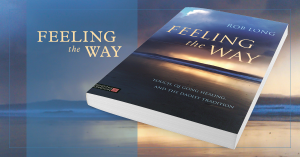 In this blog by Rob Long, author of Feeling the Way, Long examines what healing means and how it applies to our lives.
In this blog by Rob Long, author of Feeling the Way, Long examines what healing means and how it applies to our lives.
In my new book ‘Feeling The Way’ I make the bold claim that everybody possesses what is commonly called ‘healing hands’. That means you! What appears in the book is a stripped-back, extremely practical how-to guide, based on insights from over twenty years of my own trial and error in the clinic. I have called what I do ‘Qi Sensitivity Healing’, or QHS for short, and whilst much of it is innovative, it also owes a huge debt to ancient Chinese practices, especially those of the Daoists, those progenitors of Acupuncture, herbal medicine and many other instantly recognizable modalities .
I am a Traditional Acupuncturist and Chinese-style Tui Na Masseur and also teach Qi Gong. In exploring Qi Gong and various other Oriental forms I discovered, quite by accident, that I was a hands-on healer! This changed my practice forever, and I believe, made me considerably more effective as a therapist. It also radically altered my perception of this strange, elusive phenomenon we call ‘qi’. It was the fruits of this particular breakthrough that I sought to share in writing ‘Feeling The Way’.
However, before launching ourselves gung-ho at the nuts and bolts of Qi Sensitivity Healing, it might be useful to pause a moment and ask a fundamental question: what exactly does it mean to ‘heal’ someone? Like so many things related to Daoism, the answer is not so straightforward.
I am going to argue that there is a huge difference between ‘healing’ and ‘curing’. Here in the West we often confuse these two very different concepts.
Firstly, ‘curing’. This is the fundamental aim of Western technological medicine, and when it occurs, it is wonderful. To me, curing means that a malady is diagnosed, treated and made to go away – permanently. In Traditional Chinese Medicine we also like to cure people, but what if that is simply not possible? How do we proceed, and how do we then rate our ‘medical performance’?
To me, this is where ‘healing’ comes into its own, not just as a set of procedures or techniques, but as a mindset that comprehends that much of what happens in human health is not remotely amenable to being ‘cured’ by anybody.
Some examples might be useful here. It must seem obvious to most of us that some complaints, especially the chronic ones, just can’t be made to disappear. The painful deformation caused by severe osteo-arthritis comes to mind here. So far, there are numerous interventions, but no cure, only palliative care.
Or what if it’s not an ‘illness’ at all that we confront? What if a person’s malaise stems from other, non-medical factors that nonetheless degrade the quality of life and shake their world? Take, for example, the 85 year-old woman who has just lost her husband to cancer, and now discovers that she has far less money to live on than she previously imagined. Perhaps her children live far away and can’t help, or perhaps she has nobody at all. There is nothing medically ‘wrong’ with this woman, yet she is in great distress. Can you cure her? No. There is nothing to cure. Can you heal her? Yes you can! Perhaps not permanently – you cannot take away her grief or her poverty – but you can certainly make her life worth living. ‘Palliative’ this may be, but I see no shame in that label! Such a basic human interaction seems to me a valuable (and sadly, rare) asset to our society and is obviously not the province of any particular therapy. Instead it is achieved only by the quality of our attention as we allow our innate compassion to flow.
And that is what I mean by healing.
To read more about Feeling the Way, or to buy the book, please click here.
1 Response